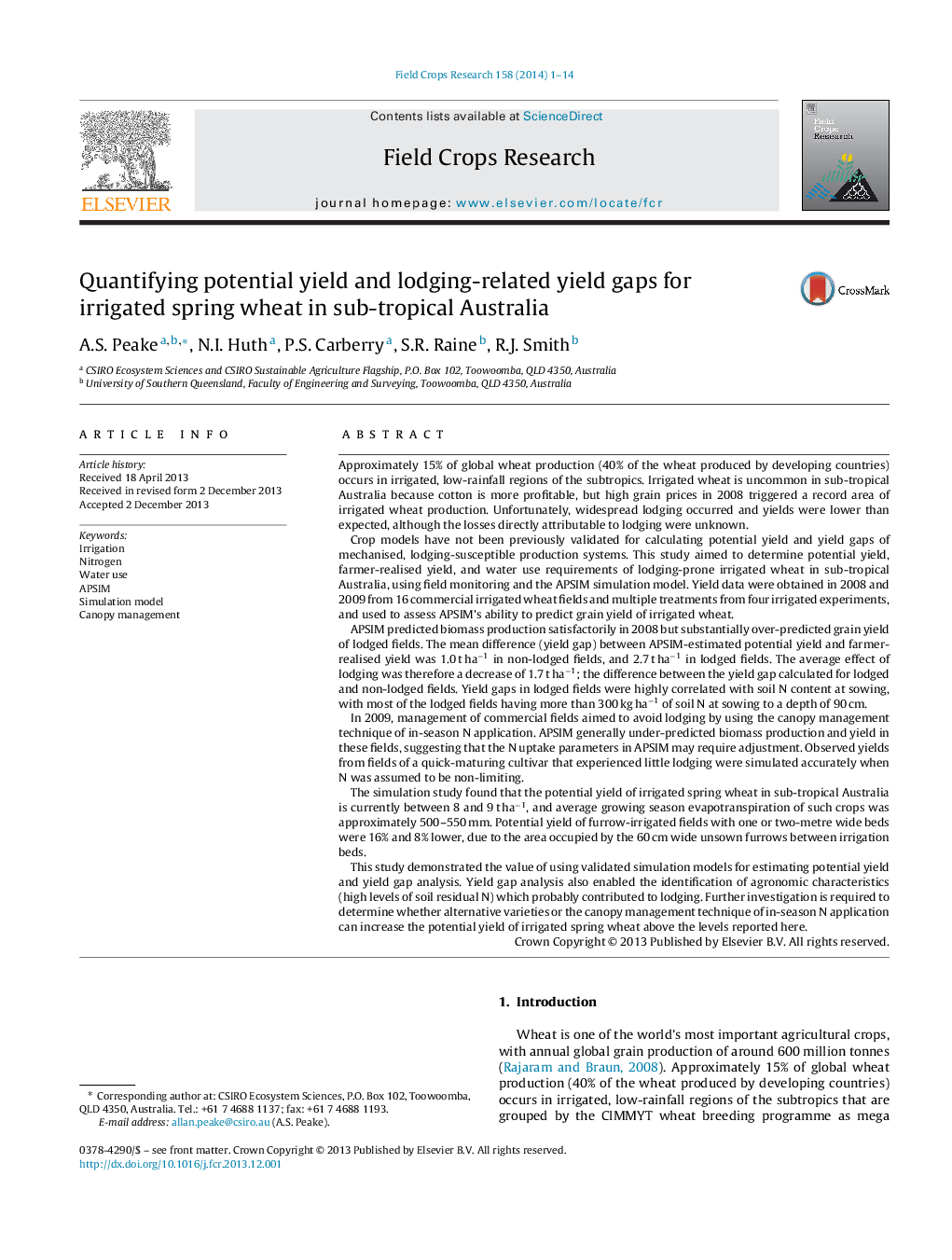| کد مقاله | کد نشریه | سال انتشار | مقاله انگلیسی | نسخه تمام متن |
|---|---|---|---|---|
| 4510135 | 1624705 | 2014 | 14 صفحه PDF | دانلود رایگان |

• Potential and farmer-realised yield was assessed for lodging-prone irrigated wheat.
• Potential (APSIM predicted) yield in the absence of lodging was 8–9 t ha−1.
• Lodging reduced farmer-realised grain yield by 1.7 t ha−1.
• The APSIM model accurately predicted yield of non-lodged crops when N was non-limiting.
• APSIM under-predicted the yield of canopy-managed crops where N was applied ‘in-season’.
Approximately 15% of global wheat production (40% of the wheat produced by developing countries) occurs in irrigated, low-rainfall regions of the subtropics. Irrigated wheat is uncommon in sub-tropical Australia because cotton is more profitable, but high grain prices in 2008 triggered a record area of irrigated wheat production. Unfortunately, widespread lodging occurred and yields were lower than expected, although the losses directly attributable to lodging were unknown.Crop models have not been previously validated for calculating potential yield and yield gaps of mechanised, lodging-susceptible production systems. This study aimed to determine potential yield, farmer-realised yield, and water use requirements of lodging-prone irrigated wheat in sub-tropical Australia, using field monitoring and the APSIM simulation model. Yield data were obtained in 2008 and 2009 from 16 commercial irrigated wheat fields and multiple treatments from four irrigated experiments, and used to assess APSIM's ability to predict grain yield of irrigated wheat.APSIM predicted biomass production satisfactorily in 2008 but substantially over-predicted grain yield of lodged fields. The mean difference (yield gap) between APSIM-estimated potential yield and farmer-realised yield was 1.0 t ha−1 in non-lodged fields, and 2.7 t ha−1 in lodged fields. The average effect of lodging was therefore a decrease of 1.7 t ha−1; the difference between the yield gap calculated for lodged and non-lodged fields. Yield gaps in lodged fields were highly correlated with soil N content at sowing, with most of the lodged fields having more than 300 kg ha−1 of soil N at sowing to a depth of 90 cm.In 2009, management of commercial fields aimed to avoid lodging by using the canopy management technique of in-season N application. APSIM generally under-predicted biomass production and yield in these fields, suggesting that the N uptake parameters in APSIM may require adjustment. Observed yields from fields of a quick-maturing cultivar that experienced little lodging were simulated accurately when N was assumed to be non-limiting.The simulation study found that the potential yield of irrigated spring wheat in sub-tropical Australia is currently between 8 and 9 t ha−1, and average growing season evapotranspiration of such crops was approximately 500–550 mm. Potential yield of furrow-irrigated fields with one or two-metre wide beds were 16% and 8% lower, due to the area occupied by the 60 cm wide unsown furrows between irrigation beds.This study demonstrated the value of using validated simulation models for estimating potential yield and yield gap analysis. Yield gap analysis also enabled the identification of agronomic characteristics (high levels of soil residual N) which probably contributed to lodging. Further investigation is required to determine whether alternative varieties or the canopy management technique of in-season N application can increase the potential yield of irrigated spring wheat above the levels reported here.
Journal: Field Crops Research - Volume 158, 1 March 2014, Pages 1–14